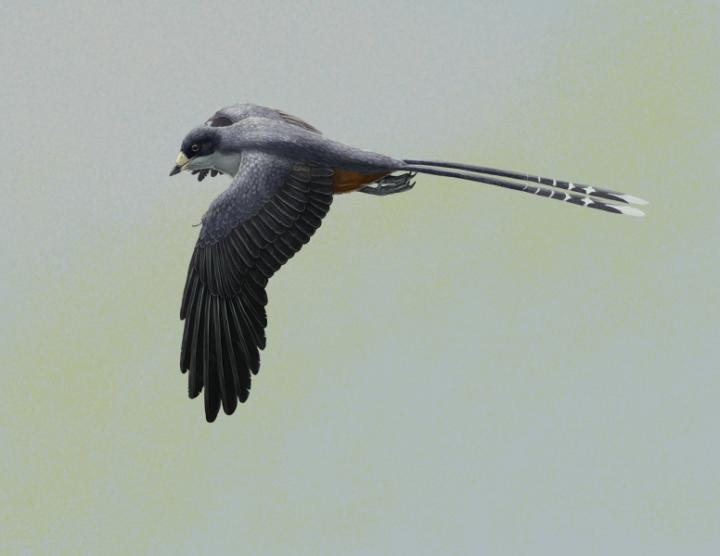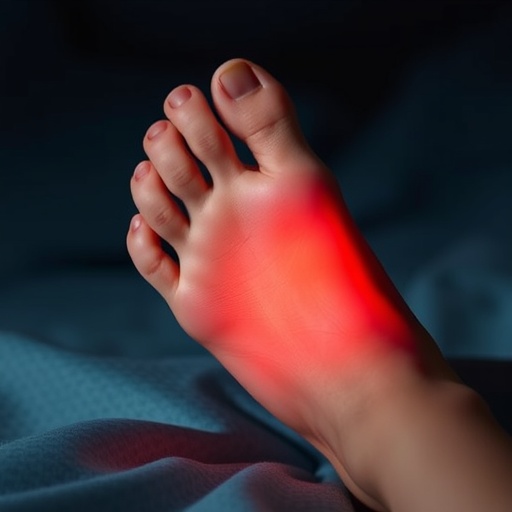
Credit: Gabriel Ugueto
Confuciusornis was a crow-like fossil bird that lived in the Cretaceous ~120 million years ago. It was one of the first birds to evolve a beak (Fig. 1). Early beak evolution remains understudied. Using an imaging technique called Laser-Stimulated Fluorescence, researchers at the University of Hong Kong (HKU) address this by revealing just how different the beak and jaw of Confuciusornis were compared to birds we see today.
Laser-Stimulated Fluorescence (LSF) is an imaging technique co-developed at HKU that involves shining a laser onto a target. It is well-known in palaeontology for making fossil bones and the soft tissues preserved alongside them glow-in-the-dark. LSF has revealed fine skin details and other previously-invisible soft tissue in a wide range of fossils, especially those of early birds and other feathered dinosaurs (see notes).
HKU PhD student Case Vincent Miller and his supervisor Research Assistant Professor Dr. Michael Pittman (Vertebrate Palaeontology Laboratory, Division of Earth and Planetary Science & Department of Earth Sciences) led this study with Thomas G. Kaye of the Foundation for Scientific Advancement (Arizona, USA) and colleagues at the Shandong Tianyu Museum of Nature (Pingyi, China). Under LSF, which was co-developed by Dr. Pittman and Mr. Kaye, the team revealed the fingernail-like ‘soft beak’ of Confuciusornis, a feature that covers the beak of every bird and is called the rhamphotheca. The example the team found in Confuciusornis was preserved detached from the bony part of the beak (Fig. 2). “Fossilised rhamphothecae have been reported in fossil birds before,” said Dr. Pittman, “but no one has really asked what they tell us about the earliest beaked birds.”
The international research team reconstructed what the beak looked like in life (Fig. 3), and used this to consolidate knowledge of the beak of Confucusornis across all known specimens. In highlighting that the rhamphotheca was easily-detachable and by performing the first test of jaw strength in a dinosaur-era bird, the team suggested that this early beaked bird was suited to eating soft foods (Fig. 4). Finally, the team highlight differences in how the beak is assembled to show that despite looking like living birds, the early beaks of Confuciusornis and its close relatives are fundamentally different structures to those seen in modern birds.
Regarding future plans, Mr. Miller said, “Our research has raised a lot of interesting questions going forward. We know so little about fossil rhamphothecae and plan on using LSF to study even more fossils to find more of these hidden gems. I am particularly interested in seeing whether beak attachment strength in living birds has any correlation with the overall strength of their jaw. This might help us to better understand fossil birds. This study is only the first glimpse into this interesting and new line of study into early beaks, so I am very excited.”
###
The paper is published in Communications Biology and can be accessed here: https:/
To view a video summary of the research.
Images download and captions: https:/
For media enquiries, please contact Ms. Casey To, External Relations Officer of HKU Faculty of Science (tel: 39174948; email: [email protected] / Ms. Cindy Chan, Assistant Director of Communications of HKU Faculty of Science (tel: 3917 5286; email: [email protected]) or Dr. Michael Pittman, Research Assistant Professor of HKU Division of Earth and Planetary Science (email: [email protected]).
Notes:
1. Landmark HKU-led volume on past progress and new frontiers in the study of early birds and their close relatives (Aug 2020):
https:/
2. Most close relatives of birds neared the potential for powered flight but few crossed its thresholds
(Aug 2020): https:/
3. Ancient birds out of the egg running (Mar 2019): https:/
4. HKU imaging technology shows first discovered fossil feather did not belong to iconic bird Archaeopteryx (Feb 2019):
https:/
5. HKU palaeontologist discovers new bird-like dinosaur with flight associated feathers – Jianianhualong tengi (May 2017):
https:/
6. Major breakthrough in knowledge of dinosaur appearance HKU palaeontologist reconstructs feathered dinosaurs in the flesh with new technology (March 2017): https:/
7. Scientists reveal how dinosaurs became able to shake their tail feathers (May 2013):
https:/
Media Contact
Cindy Chan
[email protected]
Original Source
https:/




